Petrographic Characteristics of Coal Gasification and Combustion by-Products from High Volatile Bituminous Coal
Abstract
1. Introduction
2. Materials and Methods
3. Results
3.1. Coal (CoJ)
3.2. Gasification Residue (GRJ)
3.3. Fly Ash from Coal Combustion (FACo)
3.4. Bottom Ash Resulting from Coal Combustion (BACo)
3.5. Fly Ash from the Combustion of Gasification Residue (FAGR)
3.6. Bottom Ash Resulting from the Combustion of Gasification Residue (BAGR)
4. Discussion
5. Conclusions
Funding
Acknowledgments
Conflicts of Interest
References
- Higman, C.; van der Burgt, M.; van der Burgt, M. Gasification; Gulf Professional Pub./Elsevier Science: Amsterdam, The Netherlands, 2008; ISBN 9780750685283. [Google Scholar]
- van Heek, K.H.; Mühlen, H.-J. Aspects of coal properties and constitution important for gasification. Fuel 1985, 64, 1405–1414. [Google Scholar] [CrossRef]
- Zhuo, Y.; Messenböck, R.; Collot, A.-G.; Megaritis, A.; Paterson, N.; Dugwell, D.R.; Kandiyoti, R. Conversion of coal particles in pyrolysis and gasification: Comparison of conversions in a pilot-scale gasifier and bench-scale test equipment. Fuel 2000, 79, 793–802. [Google Scholar] [CrossRef]
- Taylor, G.H.; Teichmuller, M.; Davis, A.; Diessel, C.F.K.; Littke, R.; Robert, P. Organic Petrology: A New Handbook Incorporating Some Revised Parts of Stach’s Textbook of Coal Petrology; Gebrüder Borntraeger: Berlin, Germany, 1998; ISBN 9783443010362. [Google Scholar]
- Stach, E.; Murchison, D.; Teichmüller, M.; Taylor, G.H.; Chandra, D.; Teichmüller, R.; Mackowsky, M.-T.; Teichmüller, M.; Taylor, G.H.; Chandra, D.; et al. No Title; Borntraeger: Stuttgart, Germany, 1982. [Google Scholar]
- Liu, G.S.; Niksa, S. Coal conversion submodels for design applications at elevated pressures. Part II. Char gasification. Prog. Energy Combust. Sci. 2004, 30, 679–717. [Google Scholar] [CrossRef]
- Smoliński, A. Coal char reactivity as a fuel selection criterion for coal-based hydrogen-rich gas production in the process of steam gasification. Energy Convers. Manag. 2011, 52, 37–45. [Google Scholar] [CrossRef]
- Hashimoto, K.; Miura, K.; Xu, J.-J. Gasification reactivity of various coals at a high temperature. J. Fuel Soc. Jpn. 1987, 66, 418–426. [Google Scholar] [CrossRef][Green Version]
- Wagner, N.J.; Coertzen, M.; Matjie, R.H.; van Dyk, J.C. Coal Gasification. In Applied Coal Petrology; Elsevier: Amsterdam, The Netherlands, 2008; pp. 119–144. [Google Scholar]
- Bielowicz, B. Petrographic composition of Polish lignite and its possible use in a fluidized bed gasification process. Int. J. Coal Geol. 2013, 116, 236–246. [Google Scholar] [CrossRef]
- Ministry of Energy. Polish Energy Policy until 2040 (Polityka Energetyczna Polski do 2040) PEP2040; Ministry of Energy: Warsaw, Poland, 2018.
- Lester, E.; Alvarez, D.; Borrego, A.G.; Valentim, B.; Flores, D.; Clift, D.A.; Rosenberg, P.; Kwiecinska, B.; Barranco, R.; Petersen, H.I.; et al. The procedure used to develop a coal char classification—Commission III Combustion Working Group of the International Committee for Coal and Organic Petrology. Int. J. Coal Geol. 2010, 81, 333–342. [Google Scholar] [CrossRef]
- Suárez-Ruiz, I.; Valentim, B.; Borrego, A.G.; Bouzinos, A.; Flores, D.; Kalaitzidis, S.; Malinconico, M.L.; Marques, M.; Misz-Kennan, M.; Predeanu, G.; et al. Development of a petrographic classification of fly-ash components from coal combustion and co-combustion. (An ICCP Classification System, Fly-Ash Working Group—Commission III.). Int. J. Coal Geol. 2017, 183, 188–203. [Google Scholar] [CrossRef]
- Czechowski, F.; Kidawa, H. Reactivity and susceptibility to porosity development of coal maceral chars on steam and carbon dioxide gasification. Fuel Process. Technol. 1991, 29, 57–73. [Google Scholar] [CrossRef]
- Jelonek, I.; Kruszewska, K.J.; Filipiak, P. Liptinite as an indicator of environmental changes during formation of coal seam No. 207 (Upper Silesia, Poland). Int. J. Coal Geol. 2007, 71, 471–487. [Google Scholar] [CrossRef]
- ASTM International. D388-19a Standard Classification of Coals by Rank; ASTM International: West Conshohocken, PA, USA, 2019. [Google Scholar] [CrossRef]
- UN ECE. International Classification of in-Seam Coals; UN ECE: Geneva, Switzerland, 1998. [Google Scholar]
- Ściążko, M.; Stępień, L. Boudouard reaction in fluid-bed gasification of coal chars. Przemysł Chemiczny 2014, 93, 2065–2070. [Google Scholar] [CrossRef]
- Kwiecińska, B.; Petersen, H.I. Graphite, semi-graphite, natural coke, and natural char classification-ICCP system. Int. J. Coal Geol. 2004, 57, 99–116. [Google Scholar] [CrossRef]
- Everson, R.C.; Neomagus, H.W.J.P.; Kaitano, R.; Falcon, R.; du Cann, V.M. Properties of high ash coal-char particles derived from inertinite-rich coal: II. Gasification kinetics with carbon dioxide. Fuel 2008, 87, 3403–3408. [Google Scholar] [CrossRef]
- Wagner, N.J.; Matjie, R.H.; Slaghuis, J.H.; van Heerden, J.H.P. Characterization of unburned carbon present in coarse gasification ash. Fuel 2008, 87, 683–691. [Google Scholar] [CrossRef]
- Oboirien, B.O.; Engelbrecht, A.D.; North, B.C.; Du Cann, V.M.; Verryn, S.; Falcon, R. Study on the structure and gasification characteristics of selected South African bituminous coals in fluidised bed gasification. Fuel Process. Technol. 2011, 92, 735–742. [Google Scholar] [CrossRef]
- Oboirien, B.O.; Engelbrecht, A.D.; North, B.C.; Du Cann, V.M.; Falcon, R. Textural properties of chars as determined by petrographic analysis: Comparison between air-blown, oxygen-blown and oxygen-enriched gasification. Fuel 2012, 101, 16–22. [Google Scholar] [CrossRef]
- Malumbazo, N.; Wagner, N.J.J.; Bunt, J.R.R. The petrographic determination of reactivity differences of two South African inertinite-rich lump coals. J. Anal. Appl. Pyrolysis 2012, 93, 139–146. [Google Scholar] [CrossRef]
- Hower, J.C.; Rathbone, R.F.; Robertson, J.D.D.; Peterson, G.; Trimble, A.S. Petrology, mineralogy, and chemistry of magnetically-separated sized fly ash. Fuel 1999, 78, 197–203. [Google Scholar] [CrossRef]
- Bielowicz, B. Petrographic composition of coal from the janina mine and char obtained as a result of gasification in the cfb gasifier. Gospod. Surowcami Miner. 2019, 35, 99–116. [Google Scholar] [CrossRef]
- Ahn, Y.C.; Lee, J.K. Physical, chemical, and electrical analysis of aerosol particles generated from industrial plants. J. Aerosol Sci. 2006, 37, 187–202. [Google Scholar] [CrossRef]
- Keppert, M.; Pavlík, Z.; Tydlitát, V.; Volfová, P.; Švarcová, S.; Šyc, M.; Černý, R. Properties of municipal solid waste incineration ashes with respect to their separation temperature. Waste Manag. Res. 2012, 30, 1041–1048. [Google Scholar] [CrossRef] [PubMed]
- Ribeiro, J.; Valentim, B.; Ward, C.; Flores, D. Comprehensive characterization of anthracite fly ash from a thermo-electric power plant and its potential environmental impact. Int. J. Coal Geol. 2011, 86, 204–212. [Google Scholar] [CrossRef]
- Hower, J.C.; Trimble, A.S.; Eble, C.F. Temporal and spatial variations in fly ash quality. Fuel Process. Technol. 2001, 73, 37–58. [Google Scholar] [CrossRef]
- Mardon, S.M.; Hower, J.C. Impact of coal properties on coal combustion by-product quality: Examples from a Kentucky power plant. Int. J. Coal Geol. 2004, 59, 153–169. [Google Scholar] [CrossRef]
- Varma, A.K.; Kumar, M.; Saxena, V.K.; Sarkar, A.; Banerjee, S.K. Petrographic controls on combustion behavior of inertinite rich coal and char and fly ash formation. Fuel 2014, 128, 199–209. [Google Scholar] [CrossRef]
- Cammarota, A.; Chirone, R.; Solimene, R.; Urciuolo, M. Beneficiation of pulverized coal combustion fly ash in fluidised bed reactors. Exp. Therm. Fluid Sci. 2008, 32, 1324–1333. [Google Scholar] [CrossRef]
- Bilen, M.; Kizgut, S.; Akkaya, B. Prediction of unburned carbon in bottom ash in terms of moisture content and sieve analysis of coal. Fuel Process. Technol. 2015, 138, 236–242. [Google Scholar] [CrossRef]
- Levandowski, J.; Kalkreuth, W. Chemical and petrographical characterization of feed coal, fly ash and bottom ash from the Figueira Power Plant, Paraná, Brazil. Int. J. Coal Geol. 2009, 77, 269–281. [Google Scholar] [CrossRef]
- Bunt, J.R.; Wagner, N.J.; Waanders, F.B. Carbon particle type characterization of the carbon behaviour impacting on a commercial-scale Sasol-Lurgi FBDB gasifier. Fuel 2009, 88, 771–779. [Google Scholar] [CrossRef]
- Wagner, N.J.; Coertzen, M.; Matjie, R.H.; van Dyk, J.C. Chapter 5—Coal Gasification. In Applied Coal Petrology; Academic Press: Cambridge, MA, USA, 2008; pp. 119–144. ISBN 9780080450513. [Google Scholar]
- Chmielniak, T.; Sobolewski, A.; Tomaszewicz, G. CO2-Enhanced coal gasification. Experience of the Institute for Chemical Processing of Coal Zgazowanie węgla przy wykorzystaniu CO2 jako czynnika zgazowującego. Doświadczenia IChPW. Przemysł Chem. 2015, 1, 16–22. [Google Scholar] [CrossRef]
- Błaszczuk, A.; Nowak, W.; Jagodzik, S. Bed-to-wall heat transfer in a supercritical circulating fluidised bed boiler. Chem. Process Eng. 2014, 35, 191–204. [Google Scholar] [CrossRef]
- ISO. ISO 7404-2:2009—Methods for the Petrographic Analysis of Coals—Part. 2: Methods of Preparing Coal Samples; ISO: Geneva, Switzerland, 2009. [Google Scholar]
- ISO. ISO 7404-3:2009—Methods for the Petrographic Analysis of Coals—Part. 3: Method of Determining Maceral Group Composition; ISO: Geneva, Switzerland, 2009. [Google Scholar]
- ISO 7404-5:2009—Methods for the Petrographic Analysis of Coals—Part 5: Method of Determining Microscopically the Reflectance of Vitrinite. Available online: https://www.iso.org/standard/42832.html (accessed on 30 January 2018).
- Hower, J.C.; Mastalerz, M. An Approach toward a Combined Scheme for the Petrographic Classification of Fly Ash.). Energy Fuels. 2001, 15, 1319–1321. [Google Scholar] [CrossRef]
- ISO—ISO 579:2013—Coke—Determination of Total Moisture. Available online: https://www.iso.org/standard/62608.html (accessed on 17 June 2020).
- ISO—ISO 1171:2010—Solid Mineral Fuels—Determination of Ash. Available online: https://www.iso.org/standard/55944.html (accessed on 17 June 2020).
- ISO—ISO 562:2010—Hard Coal and Coke—Determination of Volatile Matter. Available online: https://www.iso.org/standard/55943.html (accessed on 17 June 2020).
- ISO—ISO 351:1996—Solid Mineral Fuels—Determination of Total Sulfur—High Temperature Combustion Method. Available online: https://www.iso.org/standard/4304.html (accessed on 17 June 2020).
- ISO—ISO 1928:2009—Solid Mineral Fuels—Determination of Gross Calorific Value by the Bomb Calorimetric Method and Calculation of Net Calorific Value. Available online: https://www.iso.org/standard/41592.html (accessed on 17 June 2020).
- ISO—ISO 540:2008—Hard Coal and Coke—Determination of Ash Fusibility. Available online: https://www.iso.org/standard/41484.html (accessed on 17 June 2020).
- ISO—ISO 609:1996—Solid Mineral Fuels—Determination of Carbon and Hydrogen—High Temperature Combustion Method. Available online: https://www.iso.org/standard/4724.html (accessed on 17 June 2020).
- Wagner, M.; Lipiarski, I.; Misiak, J. A Petrographic Atlas of Subbituminous and Bituminous Coal from the Polish Deposits and from Uneconomic Occurrences; AGH: Kraków, Poland, 2008. [Google Scholar]
- Jasieńko, S.; Matuszewska, A.; John, A. Properties and structure of hard coals from the borehole Niedobczyce IG-1 in the Rybnik Coal District, Upper Silesian Coal Basin, their petrographic and group constituents. 2. Variations in petrographic composition of the coals along the depth of borehole. Fuel Process. Technol. 1995, 41, 221–232. [Google Scholar] [CrossRef]
- Wall, T.F.; Liu, G.; Wu, H.; Roberts, D.G.; Benfell, K.E.; Gupta, S.; Lucas, J.A.; Harris, D.J. The effects of pressure on coal reactions during pulverised coal combustion and gasification. Prog. Energy Combust. Sci. 2002, 28, 405–433. [Google Scholar] [CrossRef]
- Ladner, W.R.R. The products of coal pyrolysis: Properties, conversion and reactivity. Fuel Process. Technol. 1988, 20, 207–222. [Google Scholar] [CrossRef]
- van Heek, K.H.; Mühlen, H.-J. Effect of coal and char properties on gasification. Fuel Process. Technol. 1987, 15, 113–133. [Google Scholar] [CrossRef]
- Kruszewska, K.J. The reactivity of pseudovitrinite in some coals. Fuel 1998, 77, 1655–1661. [Google Scholar] [CrossRef]
- Kruszewska, K.; Misz, M. Inertynit w procesach koksowania i spalania w świetle badań mikroskopowych. Zesz. Nauk. Górnictwo Politech. Śląska 1999, 243, 81–89. [Google Scholar]
- Bielowicz, B. Changes in the structure of lignite macerals during the gasification process determined by Raman spectroscopy. Przemysl Chem. 2019, 98, 241–245. [Google Scholar] [CrossRef]
- Maciejończyk, N.; Bielowicz, B. Petrographic composition of char from the gasification of coal from the wieczorek mine after combustion. Gospod. Surowcami Miner. 2019, 35, 69–86. [Google Scholar] [CrossRef]
- Sharma, A.; Matsumura, A.; Takanohashi, T. Effect of CO2 addition on gas composition of synthesis gas from catalytic gasification of low rank coals. Fuel 2015, 152, 13–18. [Google Scholar] [CrossRef]
- Bunt, J.; Waanders, F. An understanding of the behaviour of a number of element phases impacting on a commercial-scale Sasol-Lurgi FBDB Gasifier. Fuel 2008, 87, 1751–1762. [Google Scholar] [CrossRef]
- Misiak, J. Cząstki węglowe w popiołach lotnych ze spalania węgla z polskich złóż. Gospod. Surowcami Miner. 2015, 31, 111–120. [Google Scholar] [CrossRef]
- Xue, X. Prediction for the burnout of pulverized coal in a coal-fired power plant by combining proximate analysis, coal petrography, and pulverized-coal size distribution. Energy Sources Part A Recovery Util. Environ. Eff. 2016, 38, 69–74. [Google Scholar] [CrossRef]
- Hower, J.C. Petrographic examination of coal-combustion fly ash. Int. J. Coal Geol. 2012, 92, 90–97. [Google Scholar] [CrossRef]
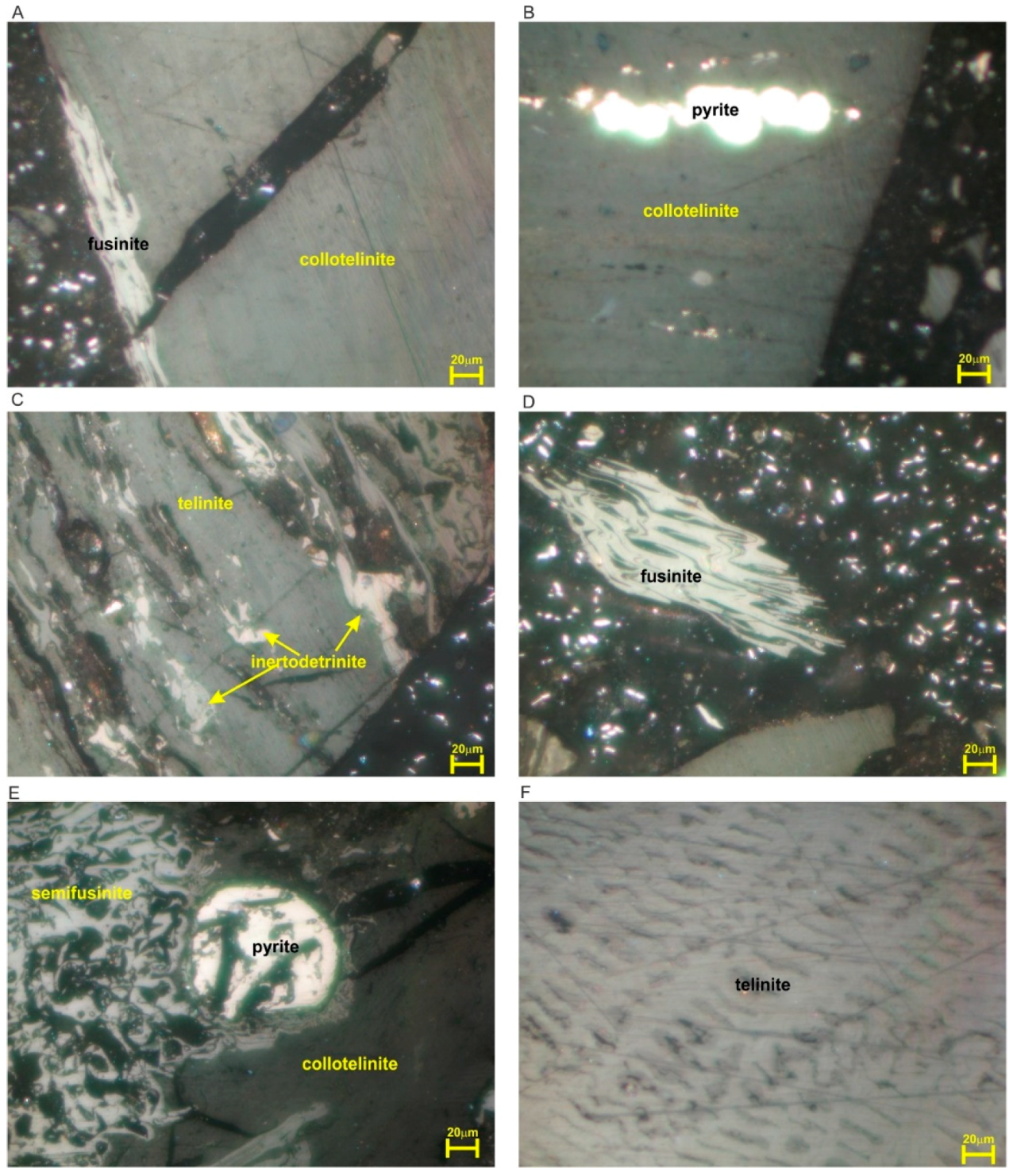

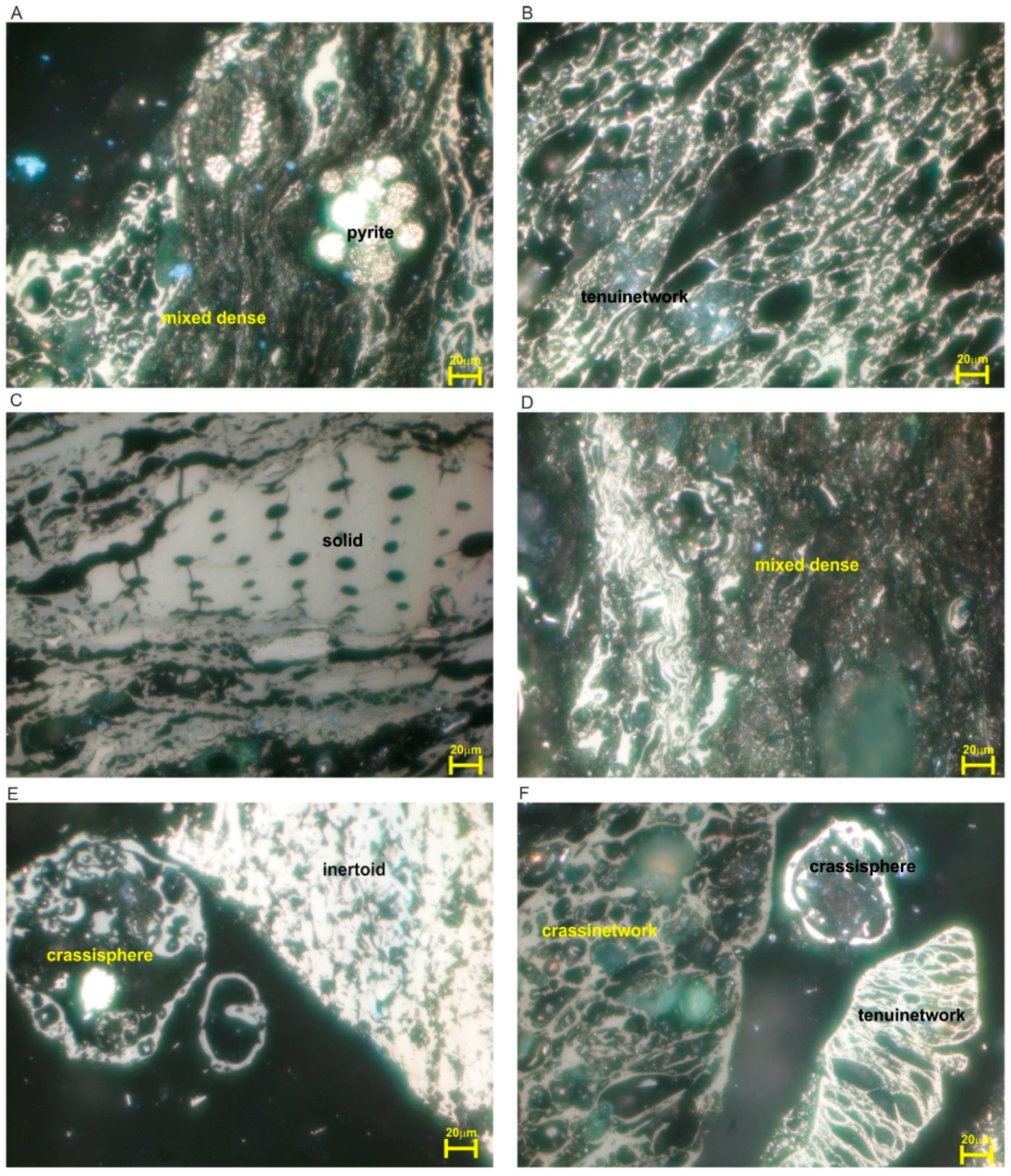
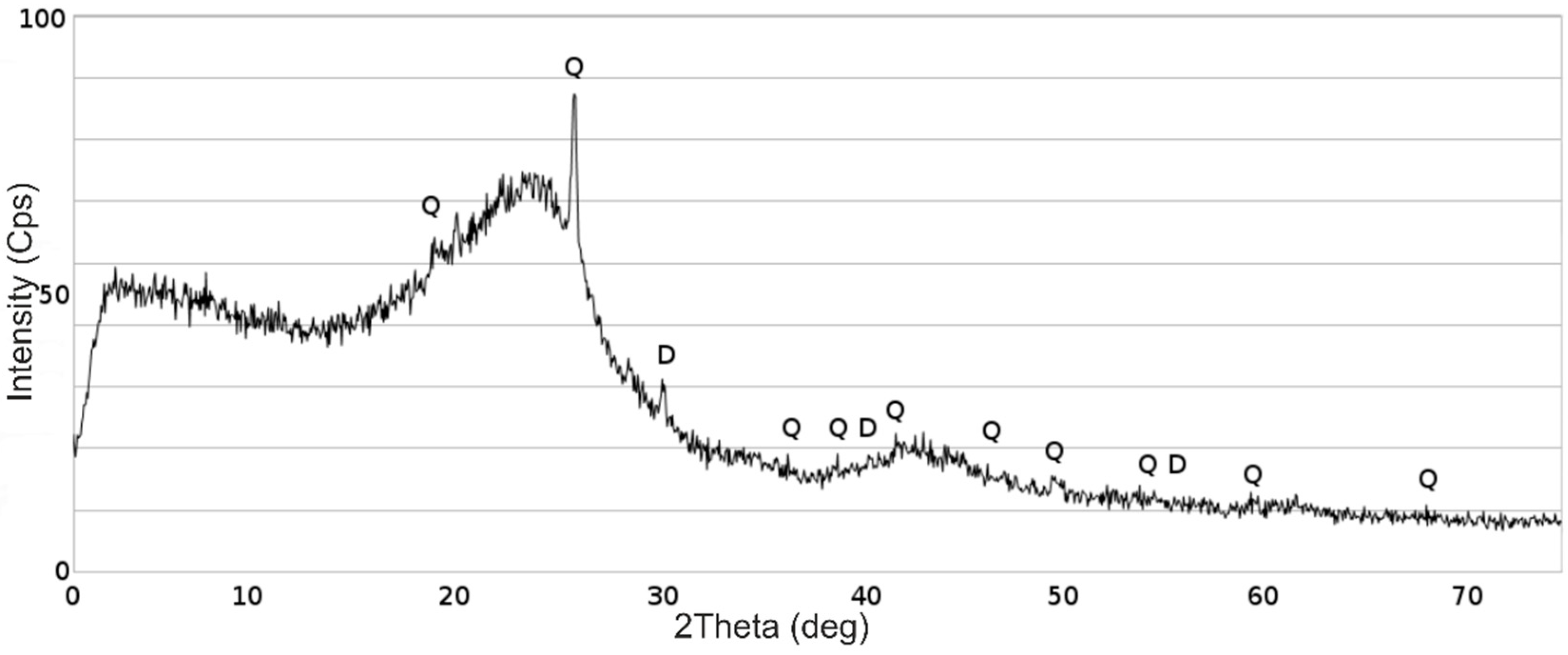
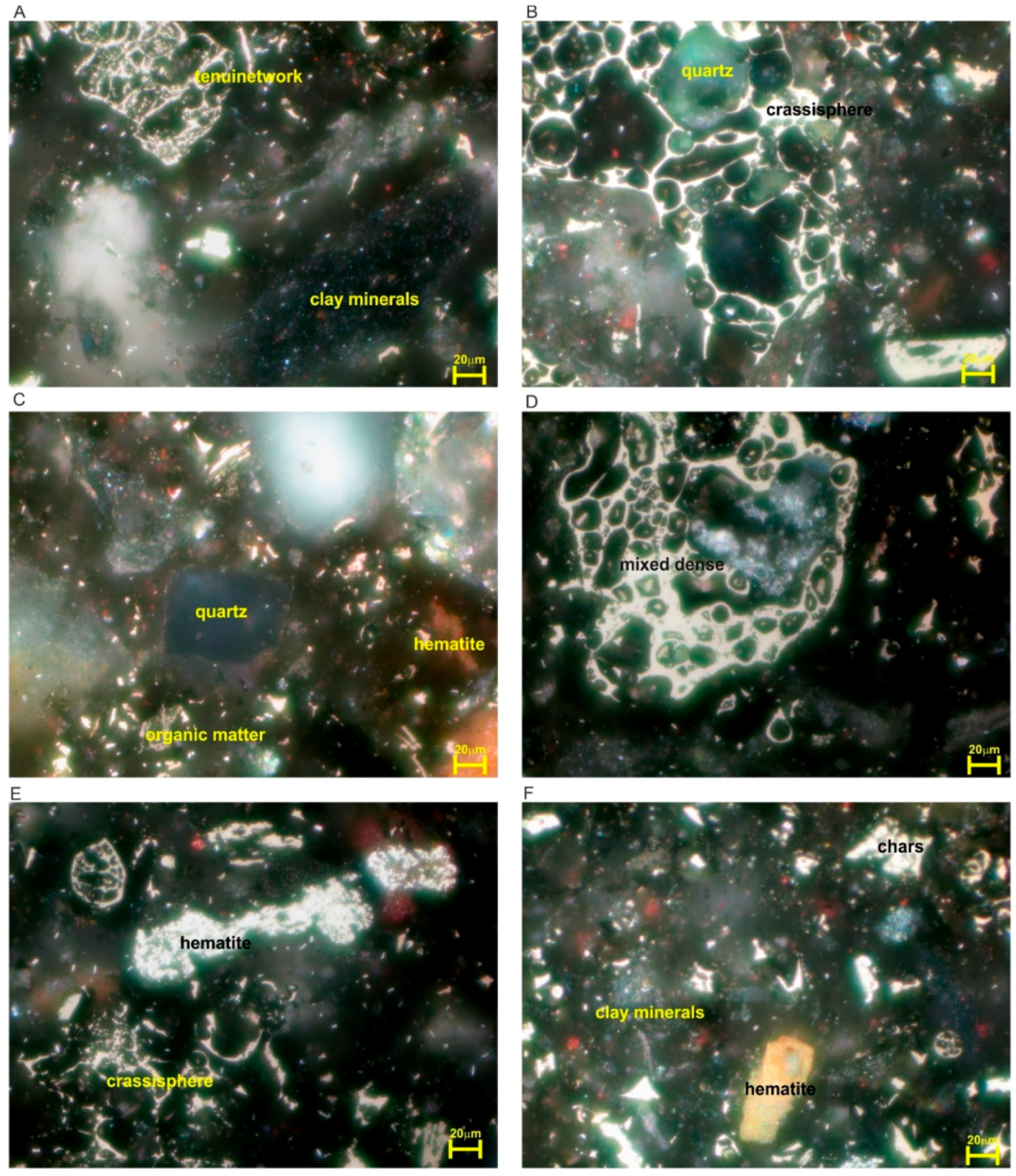
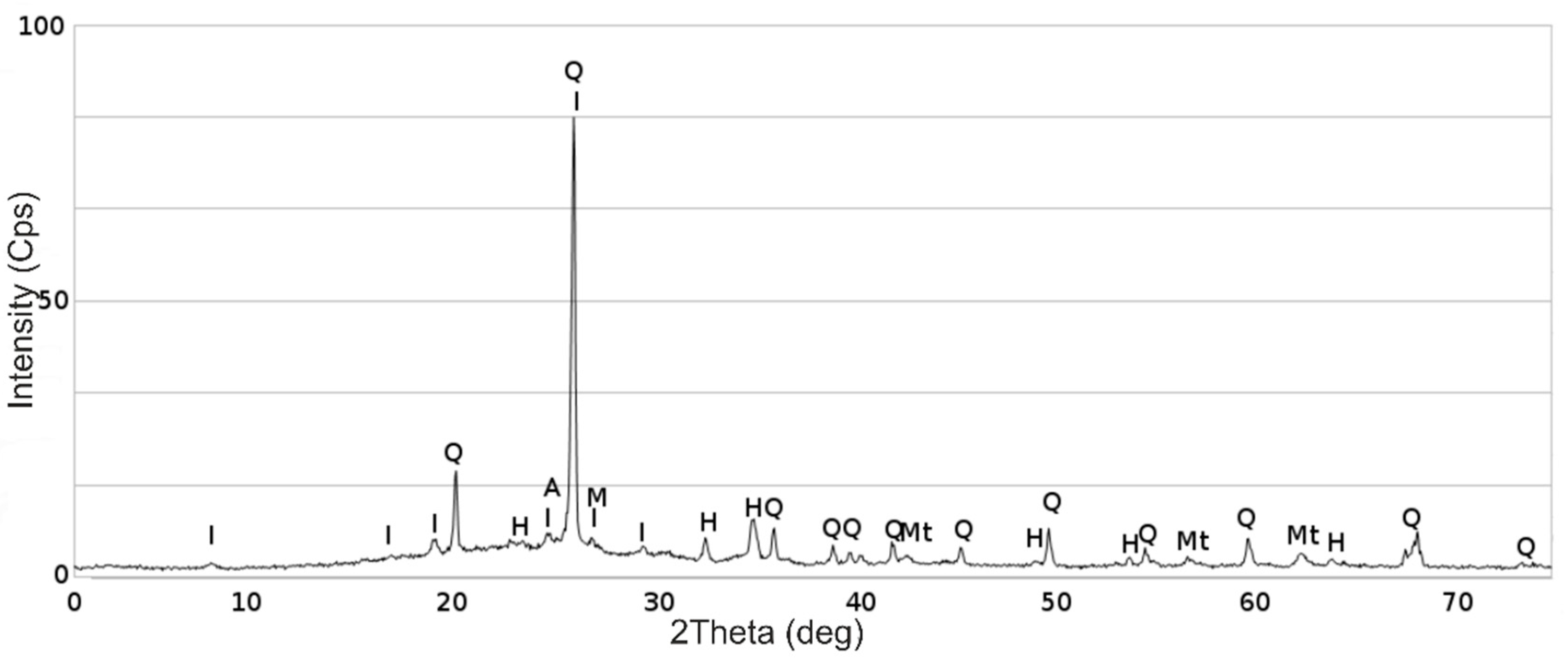
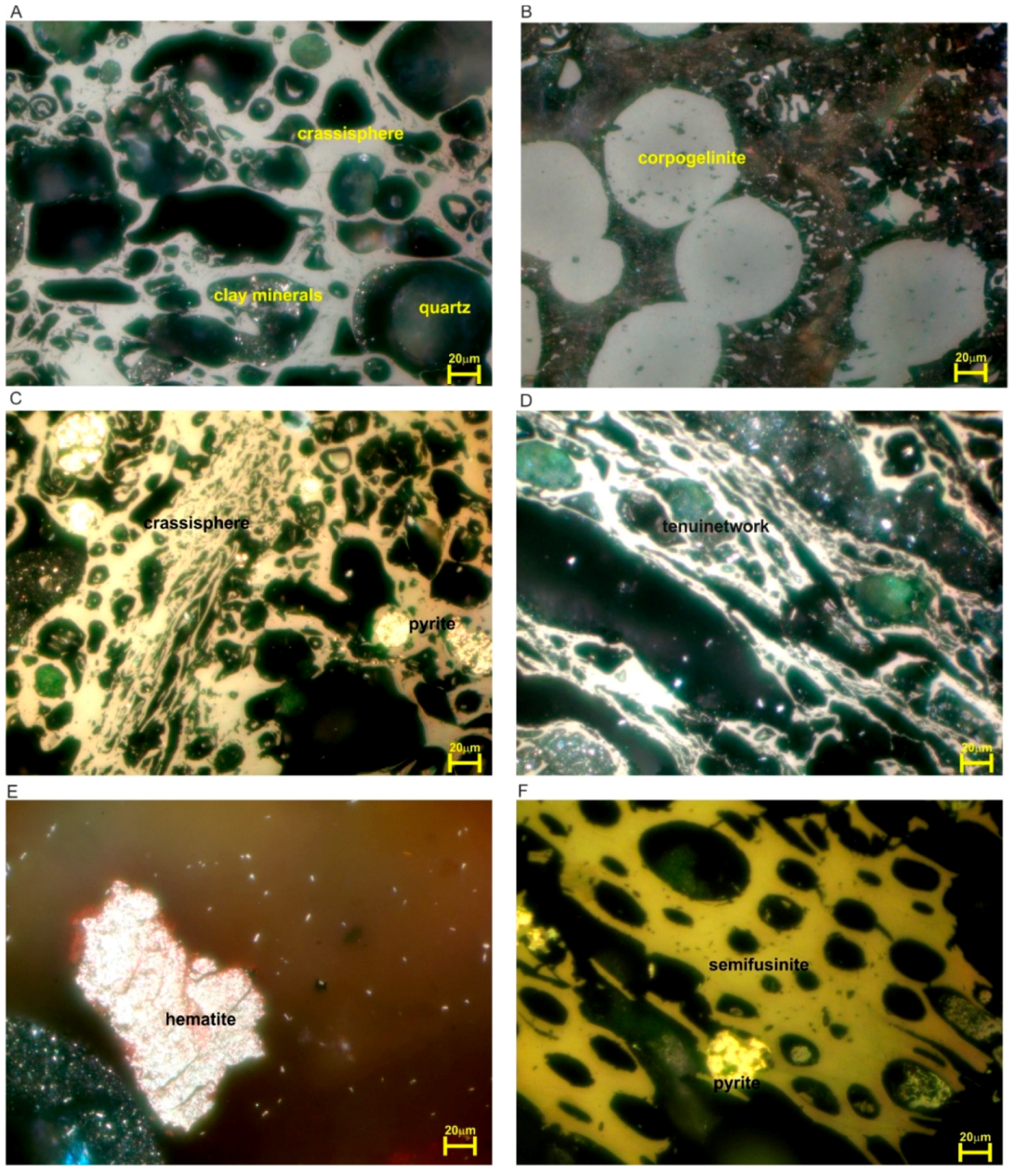
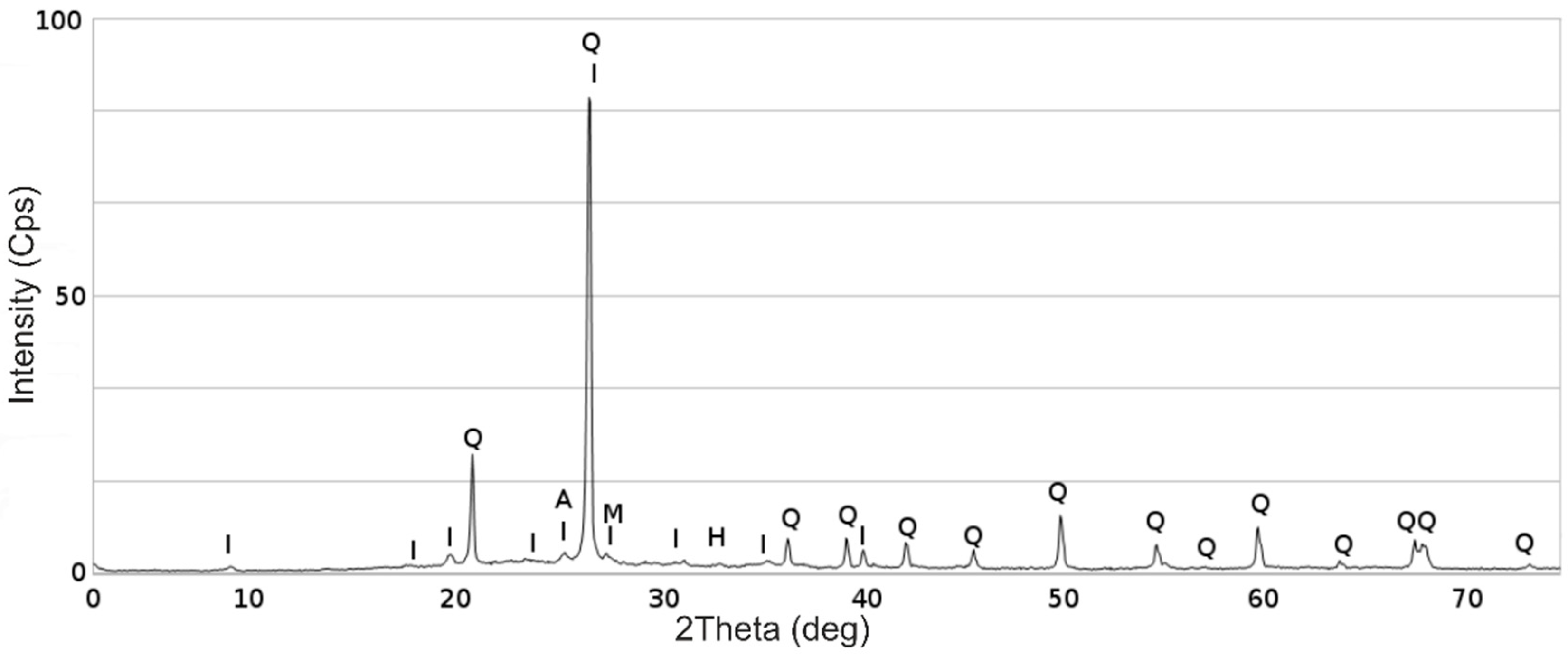

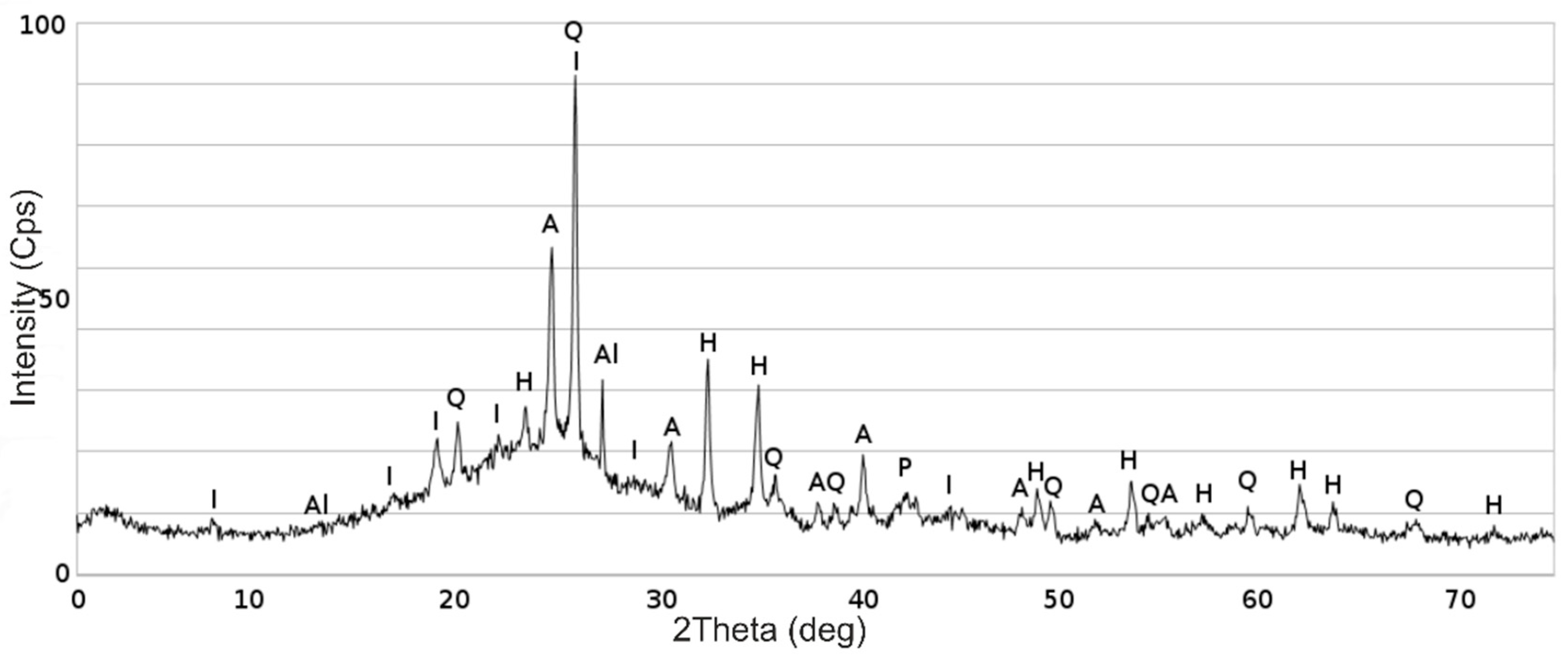
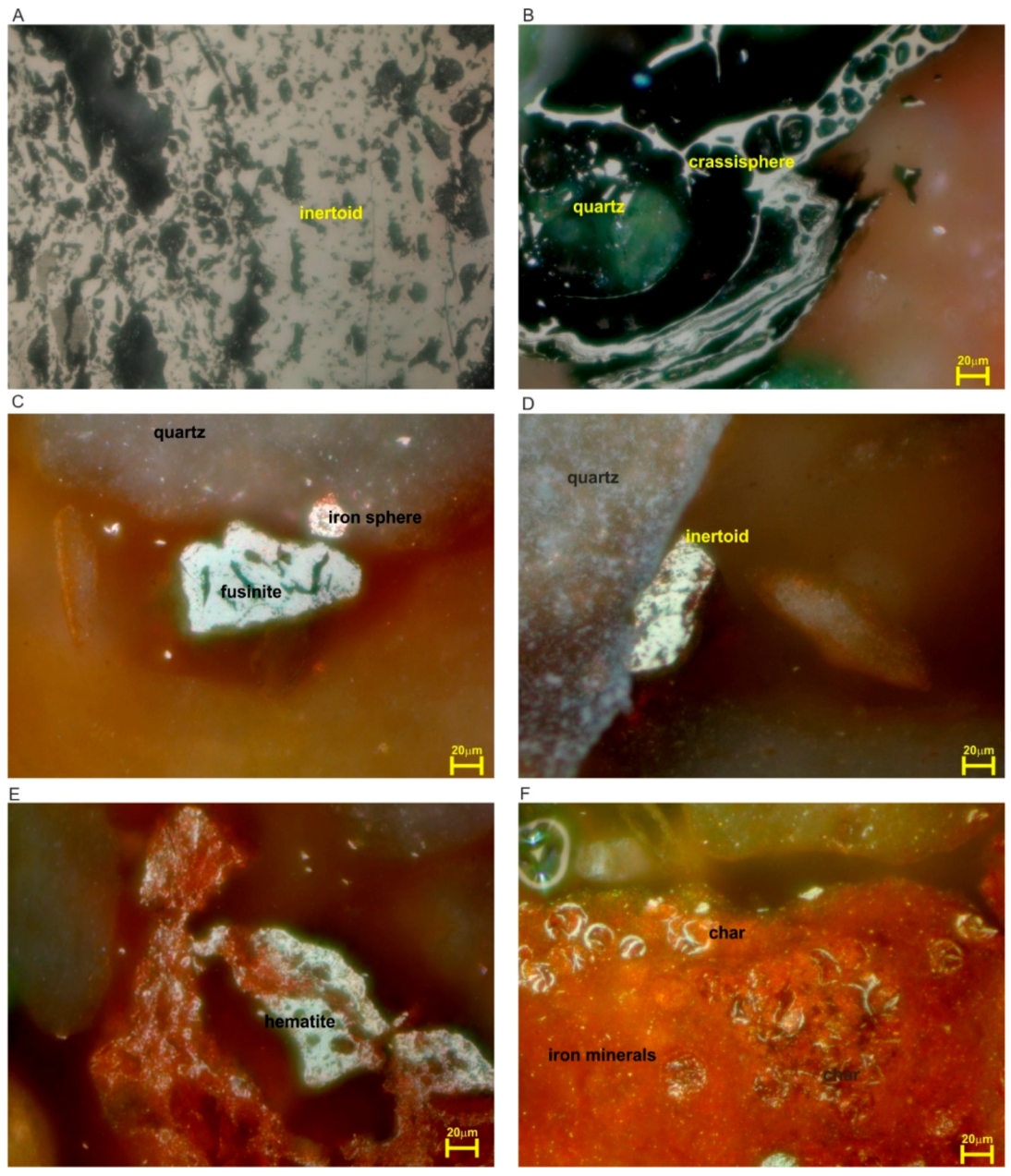
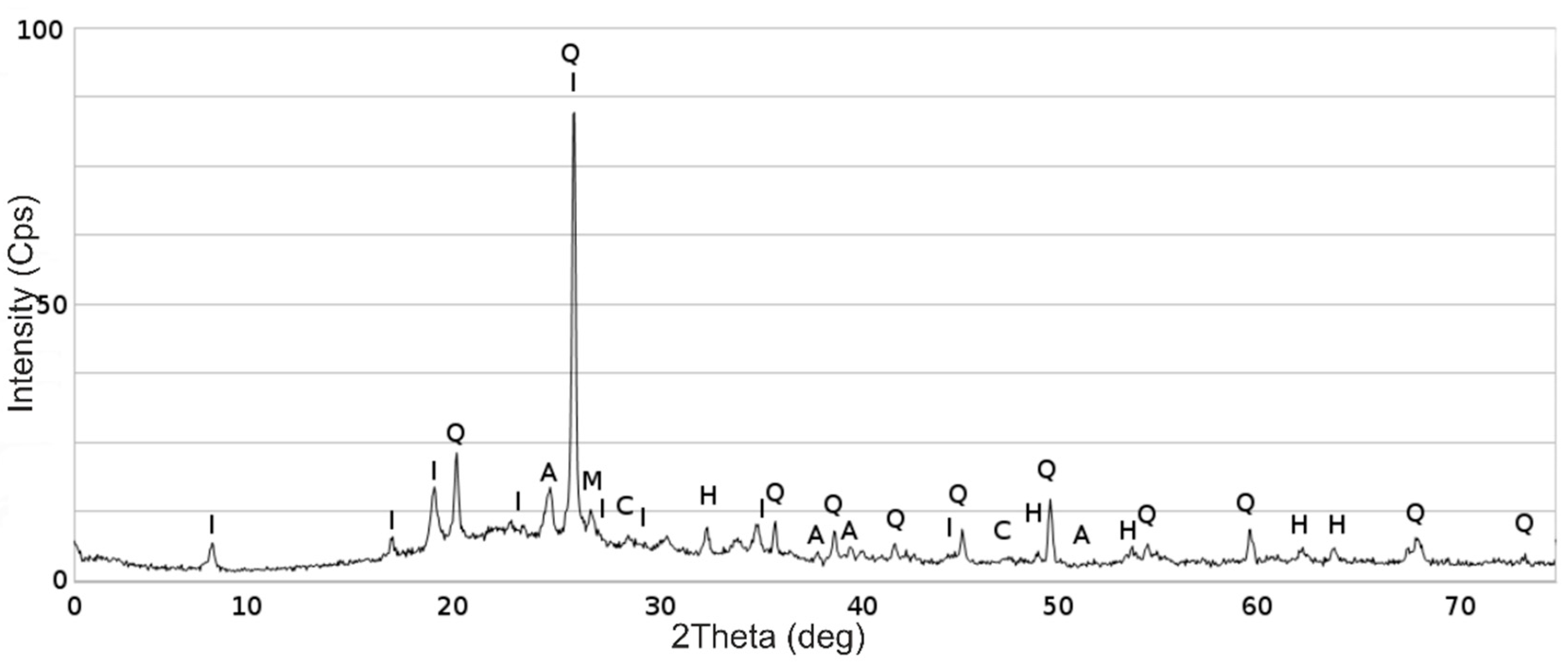
| Symbol | Sample |
|---|---|
| CoJ | Coal from Janina Mine |
| GRJ | Gasification residue from the gasification of coal |
| FACo | Fly ash from coal |
| FAGR | Fly ash from gasification residue |
| BACo | Bottom ash from coal |
| BAGR | Bottom ash from gasification residue |
| Parameter | Symbol | Unit | CoJ | GRJ |
|---|---|---|---|---|
| Moisture | M ad | % | 5.30 | 0.20 |
| Ash | A db | % | 13.80 | 24.10 |
| Volatile matter | V daf | % | 38.20 | 1.95 |
| Gross calorific value | GCV daf | MJ/kg | 31.50 | 34.40 |
| Carbon content | Ct daf | % | 79.93 | 97.30 |
| Hydrogen content | Ht daf | % | 5.14 | 0.92 |
| Nitrogen content | N daf | % | 1.30 | 1.60 |
| Total sulfur | St db | % | 1.39 | 1.09 |
| Ash sintering temperature | tS | °C | 1170 | - |
| Ash softening temperature | tA | °C | 1270 | - |
| Ash melting temperature | tB | °C | 1350 | - |
| Ash fluid temperature | tC | °C | 1360 | - |
| Coal | Gasification Residue | |||
|---|---|---|---|---|
| Maceral | Volume % | Component | Volume % | |
| Vitrinite | Telinite | 4.66 | Tenuisphere | 0.45 |
| Collotelinite | 34.27 | Crassisphere | 0.90 | |
| Collodetrinite | 18.81 | Tenuinetwork | 15.9 | |
| Corpogelinite | 0.39 | Crassinetwork | 25.11 | |
| Gelinite | 2.83 | Inertoid | 34.72 | |
| Litpinite | Sporinite | 2.99 | Fusinoid/Solid | 4.26 |
| Cutinite | 0.71 | Mixed porous | 12.46 | |
| Resinite | 0.64 | Mixed dense | 3.11 | |
| Liptodetrinite | 0.49 | Mineroid | 3.10 | |
| Alginite | 0.00 | |||
| Inertinite | Fusinite | 11.38 | ||
| Semifusinite | 7.17 | |||
| Macrinite | 2.14 | |||
| Micrinite | 1.17 | |||
| Secretinite | 0.57 | |||
| Funginite | 0.88 | |||
| Inertodetrinite | 5.66 | |||
| Vitrinite group | 60.96 | |||
| Liptinite group | 4.83 | |||
| Inertinite group | 28.97 | |||
| Mineral matter | 5.23 | |||
| Vitrinite (mmf) | 64.33 | |||
| Liptinite (mmf) | 5.10 | |||
| Inertinite (mmf) | 30.57 | |||
| FACo | BACo | FAGR | BAGR | |
|---|---|---|---|---|
| Component | volume % | volume % | volume % | volume % |
| Mineral matter | 90.00 | 75.80 | 93.72 | 95.40 |
| Char | 5.98 | 21.13 | 5.68 | 4.46 |
| Unburned coal | 4.02 | 3.07 | 0.60 | 0.14 |
| Component | Volume % |
|---|---|
| Inorganic matter | 75.80 |
| Tenuisphere | 0.00 |
| Crassisphere | 1.07 |
| Tenuinetwork | 1.38 |
| Crassinetwork | 11.79 |
| Mixed porous | 5.82 |
| Mixed dense | 0.15 |
| Inertoid | 0.92 |
| Fusinoid/Solid | 3.07 |
© 2020 by the author. Licensee MDPI, Basel, Switzerland. This article is an open access article distributed under the terms and conditions of the Creative Commons Attribution (CC BY) license (http://creativecommons.org/licenses/by/4.0/).
Share and Cite
Bielowicz, B. Petrographic Characteristics of Coal Gasification and Combustion by-Products from High Volatile Bituminous Coal. Energies 2020, 13, 4374. https://doi.org/10.3390/en13174374
Bielowicz B. Petrographic Characteristics of Coal Gasification and Combustion by-Products from High Volatile Bituminous Coal. Energies. 2020; 13(17):4374. https://doi.org/10.3390/en13174374
Chicago/Turabian StyleBielowicz, Barbara. 2020. "Petrographic Characteristics of Coal Gasification and Combustion by-Products from High Volatile Bituminous Coal" Energies 13, no. 17: 4374. https://doi.org/10.3390/en13174374
APA StyleBielowicz, B. (2020). Petrographic Characteristics of Coal Gasification and Combustion by-Products from High Volatile Bituminous Coal. Energies, 13(17), 4374. https://doi.org/10.3390/en13174374





